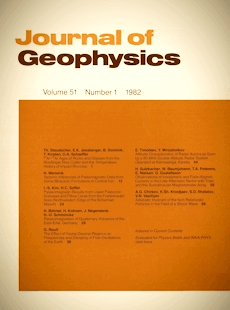Source parameters of mine tremors in the eastern part of the Ruhr district (West Germany)
Article Sidebar

Vols. 1-18 (1924-1944), ISSN 0044-2801
Main Article Content
Abstract
About 190 mine tremors were recorded during a 120 day period in the eastern part of the Ruhr district (West Germany). Source parameters of 37 tremors (1.3 ≤ ML ≤ 2.3) are calculated. Hypocentral distance was about 2 km. A combined plot of first P-wave motions in an equal area projection of a focal sphere possibly suggests a dip slip mechanism. Displacement P-wave spectra of 13 events show a clear low frequency level and a high frequency asymptotic behaviour as f –3, where f is the frequency. Seismic moment varies from 2.3 x 1018 dyn cm to 2.3 x 1019 dyn cm. Corner frequencies are in the range of 12–16 Hz. Interpretation of spectra with Brune's (1970) model extended by Hanks and Wyss (1972) leads to source dimensions between 87 m and 120 m. Stress drops vary from 0.9 bars to 8.4 bars. Average dislocations range from 0.6 mm to 19 mm. Stress drop, dislocation, and seismic moment have a clear dependence on radiated seismic energy. Seismic energy of the mine tremors is between 1.4 x 1013 ergs and 2.2 x 1015 ergs. The energy magnitude relation log E = 11.8 + 1.5 M given by Gutenberg and Richter is in good agreement with the data. Source dimensions are in the same range as those found for mine tremors in Utah, South Africa, and Poland.
 ARK: https://n2t.net/ark:/88439/y073859
ARK: https://n2t.net/ark:/88439/y073859
Permalink: https://geophysicsjournal.com/article/290
Article Details
References
Aki, K. (1967) Scaling law of seismic spectrum. J. Geophys. Res. 72:1217-1231
Aki, K. (1980) Source mechanism and earthquake prediction. Editions du Centre National de la Recherche Scientifiq ue, 15, quai Anatole-France, Paris, pp. 23-50
Archambeau, C.B. (1964) Elastodynamic source theory. Ph.D. thesis, Cal. Inst. Tech., Pasadena
Baule, H., Hinzen, K.-G. (1981) Erfassung und Deutung von Erderschi.itterungen, insbesondere zur Ortung von Gebirgsschlagen. Schlul3bericht i.A. des Landesoberbergamtes und Wirtschaftsministeriums NW. Inst. f. Geophys., Ruhr-Univ. Bochum
Berckhemer, H., Jacob, K.H. (1968) Investigation of dynamical process in an earthquake foci by analyzing the pulse shape of body waves. Ber. Inst. Meteor. Geophys., Univ. Frankfurt/Main, 13
Boatwright, J. (1980) A spectral theory of circular seismic sources; simple estimates of source dimension, dynamic stress drop, and radiated seismic energy. Bull. Seism. Soc. Am. Vol. 70(1):1-26
Brune, J .N. (1970) Tectonic stress and spectra of seismic shear waves from earthquakes. J. Geophys. Res. 75:4997-5009
Brune, J.N. (1971) Tectonic stress and spectra of seismic shear waves from earthquakes. J. Geophys. Res. 76:5002
Casten, U., Cete, A. (1980) Induzierte Seismizitat im Bereich des Steinkohlenbergbaus des Ruhrreviers. Gli.ickauf- Forschungshefte 41:12-16
Douglas, B.M., Ryall, A. (1972) Spectral characteristics and stress drop for microearthquakes near Fairwiew Peak, Nevada. J. Geophys. Res. 77:351-359
Gibbowicz, S.J., Chichowicz, A. (1977) Seismic moment and source size of mining tremors in Upper Silesia, Poland. Acta Geophysica, Polen XXV, 201-218
Gutenberg, B., Richter, C.F. (1956) Magnitude and energy of earthquakes. Ann. Geofis. (Rome) 9:1-15
Hanks, T.C., Thatcher, W. (1972) A graphical representation of seismic source parameters. J. Geophys. Res. 77:4393-4405
Hanks, T.C., Wyss, M. (1972) The use of body-wave spectra in the determination of seismic-source parameters. Bull. Seism. Soc. Am. 62:561-589
Haskell, N. (1964) Total energy and energy spectral density of elastic wave radiation from propagating faults. Bull. Seism. Soc. Am. 54:1811-1841
Kasahara, K. (1957) The nature of seismic origins as inferred from seismological and geoelectric observations. Bull. Earthquake Res. Inst. Tokyo Univ. 35:473-530
Keilis-Borok, V.J. (1957) Investigation of the mechanism of earthquakes (in Russian). Tr. Inst. Geofis. Akad. Nauk., SSSR, 40 (Engl. transl., Sov. Res. Geophys. Ser., 4, 1960)
Madariaga, R. (1976) Dynamics of an expanding circular fault. Bull. Seism. Soc. Am. Vol. 66, No. 3:639-666
Madariaga, R. (1977) Implications of stress-drop models of earthquakes for the inversion of stress drop from seismic observations. Pageoph. 115:301-316
Marion, G.E., Long, L.T. (1980) Microearthquake spectra in the south eastern United States. Bull. Seism. Soc. Am. 70:1037-1054
McGarr, A., Green, R.W.E., Spottiswoode, S.M. (1981) Strong motion of mine tremors: some implications for near-source ground motion parameters. Bull. Seism. Soc. Am. 71:295-320
McGarr, A., Spottiswoode, S.M., Gay, N.C. Ortlepp, W.D. (1979) Observations relevant to seismic driving stress, stress drop, and efficiency. J. Geophys. Res. 84:2251-2261
Pelzing, R. (1978) U ntersuchungen zur Ortung von Herden seismischer Ereignisse, dargestellt an Beispielen aus einem Stationsnetz im Ruhrgebiet. Ber. Inst. fur Geophys., Ruhr University Bochum, Nr. 6
Perret, W.R. (1972) Seismic source energies of underground nuclear explosions. Bull. Seism. Soc. Am. 62:763-774
Reid, H.F. (1910) On mass movements in tectonic earthquakes and the depth of focus. Gerlands Beitr. Geophys. 10:318-351
Richter, C.F. (1958) Elementary seismology. W.H. Freeman a.Co., San Francisco, 768 pp.
Savage, J.C. (1972) Relation of corner frequency to fault dimensions. J. Geophys. Res. 77:3788-3795
Smith, R.B., Winkler, P.L., Anderson, J.G., Scholz, C.H. (1974) Source mechanisms of microearthquakes associated with underground mines in eastern Utah. Bull. Seism. Soc. Am. 64:1295-1317
Spottiswoode, S.M., McGarr, A. (1975) Source parameters of tremors in a deep-level gold mine. Bull. Seism. Am. 65:93-112
Thatcher, W. (1972) Regional variations of seismic source parameters in the northern Baja California area. J. Geophys. Res. 77:1549-1565
Thatcher, W., Hanks, T. (1973) Source parameters of Southern California earthquakes. J. Geophys. Res. 78:8547-8576
Westbrook, G.K., Kasznir, N.J., Browitt, C.W.A., Holdsworth, B.K. (1980) Seismicity induced by coal mining in Stoke-on-Trent (U.K.). Engin. Geol. 16:225-241
Wyss, M. (1970) Stress estimates for South American shallow and deep earthquakes. J. Geophys. Res. 75:1529-1544











